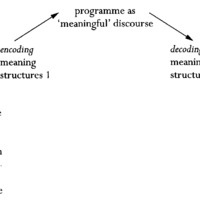-
Title
-
Encoding/Decoding
-
Description
-
Clearly, what we have labeled in the diagram 'meaning structures 1' and 'meaning structures 2' may not be the same. They do not constitute an 'immediate identity.' The codes of encoding and decoding may not be perfectly symmetrical. The degree of symmetry—that is, the degrees of 'understanding' and 'misunderstanding' in the communicative exchange — depend on the degrees of symmetry/asymmetry (relations of equivalence) established between the positions of the 'personifications', encoder-producer and decoder-receiver. But this in turn depends on the degrees of identity or non-identity between the codes, which perfectly or imperfectly transmit, interrupt or systematically distort what has been transmitted. The lack of fit between the codes has a great deal to do with the structural differences of relation and position between broadcasters and audiences, but it also has something to do with the asymmetry between the codes of 'source' and 'receiver' at moment of transformation into and out of the discursive form. What are called 'distortions' or 'misunderstandings' arise precisely from the lack of equivalence between the two sides in the communicative exchange. Once again, this defines the 'relative autonomy', but 'determinateness', of the entry and exit of the message in its discursive moments.
-
Designer
-
Hall, Stuart
-
Date
-
1973
-
Source
-
"Encoding/Decoding"
-
Bibliographic Citation
-
Hall, Stuart. "Encoding, Decoding." In The Cultural Studies Reader (Second Edition, 1999). Edited by Simon During. Routledge: Taylor and Francis Group. Page 510.
-
Stuart Hall. 1973. "Encoding, decoding." In Culture, Media, Language. Working Papers in Cultural Studies, 1972-1979. Edited by Stuart Hall, Dorothy Hobson, Andrew Lowe, and Paul Willis. Centre for Contemporary Cultural Studies, University of Birmingham. Routledge.
-
has attribute
-
English
Arrow
-
English
Dash Line
-
English
Solid Line
-
depict things of type
-
English
Sequence or Process
-
Coverage
-
communication

